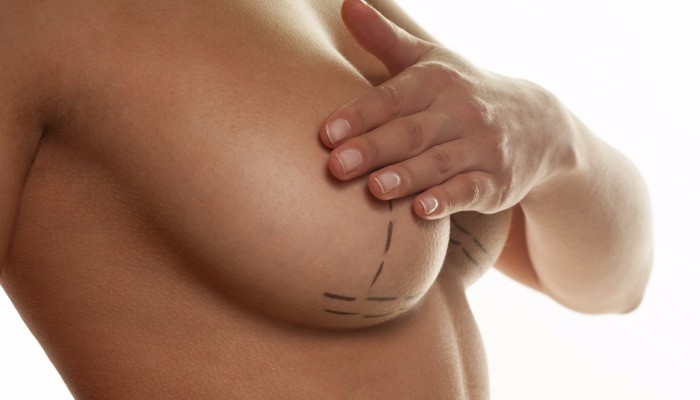
As we get older, the skin suffers many changes, but one of the most common is the loss of its elasticity. One consequence of this is the change in the breast’s appearance; this, added to pregnancy, breastfeeding, weight fluctuations, gravity, and heritage, produces a drop of the breasts. Small breasts tend to maintain their shape; however, women with large breasts usually note important changes in their firmness and shape.
A breast lift, also called “mastopexy,” is a plastic surgery that allows the breasts to rise because the plastic surgeon eliminates excessive skin and reinforces the rest of the tissues in the chest, resulting in a more defined, firmer, and younger-looking breast. Additionally, with this surgery, the plastic surgeon may also repair enlarged areolas. Experts consider this surgery to be the best treatment for women who desire to correct droopy breasts, especially when the changes are just beginning. Likewise, this surgery is very common for women who want to recover their “pre-mom” bodies, which is why, in many cases, this procedure forms part of a “mommy makeover.” The patient can get a breast lift at any age, after her breasts have finished developing. She can also get the surgery before or after being pregnant; patients who undergo this procedure are able to breastfeed even after the surgery.
Breast lift surgery does not significantly change the size of the breast or round out the upper part. If a woman is considering a surgical breast lift, one way to determine whether or not it might help her is by putting a pencil under the breast and seeing if the position is held; if it is, a breast lift might be an option. Otherwise, if the patient wants her breasts to look fuller, she should consider a breast lift in combination with a breast augmentation; if, on the contrary, she desires smaller breasts, the patient should consider undergoing a breast lift and a breast reduction.
A breast lift is different from a breast reduction. During a breast reduction, the plastic surgeon can reduce large, heavy breasts and make them smaller; meanwhile, a breast lift surgery just returns the breasts to a youthful position on the chest. In fact, these procedures are often combined. A breast lift may also be combined with a breast augmentation; this elevates and enlarges the breast in the same procedure.
Statistics of the American Society of Plastic Surgeons report that breast lift procedures are increasing in frequency, surpassing breast implant surgeries. In 2013, more than 90,000 breast lift procedures were performed by ASPS surgeons.
What are the benefits of a breast lift?
– After the procedure, the patient will have firm and contoured breasts, with more projection and symmetry.
– The patient’s breasts will look more youthful.
– The patient will look better in and out of clothes.
– The patient will feel more self-confident.
What are the disadvantages of a breast lift?
– The effects of a breast lift might change over time from the effects of gravity and aging.
– This surgery leaves visible scars, but they will be hidden in a bra or swimsuit.
– If the patient gets pregnant again, the results of the surgery may change.
Who is an ideal breast lift candidate?
Patients who are physically healthy; usually maintain their weight; have a positive attitude and realistic expectations; feel their breasts are sagging and have less volume; feel their breasts have changed their shape or are becoming flat and more pendulous, but are adequate in size; think the nipples and areolas are at the breast crease (pointing downward); think the skin has stretched and the areolas have enlarged; and patients who think that the breasts are asymmetric (one breast may appear firm and well positioned while the other does not).
How much does a breast lift cost?
The average cost of a breast lift is $4,377, according to the American Society of Plastic Surgeons. However, breast lift surgery costs always vary. This cost mentioned above does not include extra fees like anesthesia, room facilities, and other expenses.
This surgery is usually considered a cosmetic surgery, so most health insurance plans will not cover the expenses unless they are done as part of a mastectomy reconstruction.
Likewise, if the patient desires other results and has decided to combine the mastopexy with another procedure, the cost is higher. For example, if the patient wants to add implants during the procedure, this may add approximately $1,000 to the final cost of the treatment. Again, however, prices will vary. (For example, silicone implants cost more than saline implants.)
What should a patient do before a breast lift surgery?
The first step is to select a qualified plastic surgeon. During the consultation, the patient should discuss all of her desires and worries with the physician. The physician will examine the patient’s body, and in most cases will ask for some lab tests to determine her general health condition. Likewise, it is important for the patient to be completely honest about her medical record (including current medication and allergies), especially any family history of breast cancer.
During the examination, the plastic surgeon should determine the patient’s skin elasticity on the breasts, and the location of her breasts on her chest. Likewise, the physician will assess the degree of sagging of the breasts, and the complex nipple-areola position. All this helps to decide the amount of skin and fat that should be removed.
During the consultation, the best surgical technique for the patient should also be decided according to her physical characteristics and desires (in this case, the plastic surgeon’s opinion is very important). The patient should communicate all her expectations and desires to the plastic surgeon, as good communication allows the patient to obtain the best results possible. At this point, the patient should decide if she wants to get breast implants as a complement to the surgery.
The patient should follow all of the plastic surgeon’s recommendations, especially if they ask them to get lab tests, take certain medications, or adjust her current medications. It is important for the patient to undergo a mammogram before and after the procedure, and to keep those scans as a baseline to help detect any future changes in her breast tissue. Also, she should stop smoking and avoid any medication that may cause bleeding.
What is the general procedure of a breast lift?
In most cases, the patient will be under general anesthesia; however, the plastic surgeon may choose local anesthesia with intravenous sedation as the best option for some patients. Once the operation has begun, the surgeon may decide to combine various techniques or change a technique to ensure the best result. The procedure takes about three hours.
The breast lift procedure can be performed through different incisions and techniques. The technique to be used in each case will be decided by the surgeon according to the breast size and shape, the size and position of the areolas, the degree of breast sagging, the skin characteristics and elasticity, and the amount of extra skin.
The most common incision in a breast lift surgery is one called an “anchor-shaped incision.” In this case, the plastic surgeon makes the incision around the areola, at its border, and then goes down vertically until reaching the breast’s crease; after that, a third incision is made along this natural curve. These three incisions leave permanent scars. However, this standard incision has been the most commonly used, and experts affirm that it reduces sagging, especially in the breast’s inferior half. Most women obtain excellent results with this method, but it is mostly recommended for women with smaller breasts.
Another type of incision is “donut mastopexy”—using this method, the plastic surgeon eliminates less skin than in the traditional one. With this technique, the patient has a shorter recovery time and will also have less scarring. When using this method, the plastic surgeon creates the incision in the border of the nipple-areola complex circumferentially. This incision removes less tissue. This technique is better for changing the shape and size of the areolas. In patients with big breasts, this technique is not recommended.
The third type of incision is the “lollipop breast lift” (or vertical mastopexy); it represents a middle ground between the two methods above. In this case, the plastic surgeon makes 2 incisions, one around the areola, and other vertically down to the breast crease. It is recommended for patients who desire a more discreet lift. The scar from this technique is less visible than the one produced with a traditional (anchor pattern) incision; however, in the case of a donut incision, the plastic surgeon has less opportunity to manipulate the tissues.
On the other hand, a laser bra breast lift represents a new technique used as an alternative to the traditional procedure. It is a good option with excellent and durable results to treat sagging breasts. When the plastic surgeon performs a traditional mastopexy, they can only eliminate the excessive skin, but with this technique, they may also add support to the inferior half of the treated breasts. This technique may be used in all women because it can treat the different sizes of breasts without a problem, so all women are good candidates.
If the patient wants to recover volume in her breasts using breast implants during mastopexy, the plastic surgeon can combine these procedures to restore firmness and volume during the same surgery. When these procedures are combined, the patient obtains impressive results.
Once the plastic surgeon has removed the excessive skin, they reposition the nipple-areola complex, putting it in a higher position. After that, the plastic surgeon pulls down the skin over the nipple, reshaping the breast.
Once the breasts have been reshaped and all the excessive skin is cut, the incisions are closed with sutures, skin adhesives, or surgical tapes, which tighten the remaining skin. The plastic surgeon will try to make the incisions in areas where they may be hidden by the natural breast contours, but in some cases, they cannot be hidden. Although scars are usually less visible with time, they are permanent.
What is the postoperative care for a breast lift patient?
Usually this procedure is an outpatient one, meaning that there’s no overnight stay. The patient will be taken into a recovery area where she will continue to be closely monitored.
Bandages and compression garments are used to help during the healing process. In most cases, a special bra is also indicated; these garments should be used for at least 1 week, as they help to reduce chest movements and maintain the shape of the operated breast.
Likewise, they help to reduce pain and discomfort and avoid letting the incisions open. In some cases, the surgeon leaves drains in the operated area to eliminate the remaining fluid and to speed the healing process.
The patient’s movements should be limited during the first postoperative day, so someone should take care of her. Likewise, the patient should take a rest from work (1 week minimum) without bending or lifting the arms; several days after surgery, the patient can restore movement until it is comfortable enough. The patient will have to avoid heavy lifting for at least 4 to 6 weeks after the surgery, so if she has young children, she may need to look for help.
Incisions will be red at first and normally stay this way for several months following surgery. After a breast lift surgery, the patient can usually go back to work within a month or less (depending on the nature of the work).
The recovery process for a breast lift may vary from patient to patient; however, there is not a specific period of time, as the recovery time will depend on the surgical method that was used, the healing ability of each patient, and the postoperative care. It is important to follow the plastic surgeon’s indications until the healing process is complete; this will prolong results and reduce the possibility of complications.
Dr. Amjadi MD, DDS, FACS
Certified by the American Board of Plastic Surgeons
915 Gessner Rd #870
Houston, TX 77024
713-465-6198













